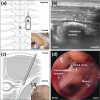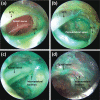Influence of injectate volume on paravertebral spread in erector spinae plane block: An endoscopic and anatomical evaluation
- PMID: 31658293
- PMCID: PMC6816541
- DOI: 10.1371/journal.pone.0224487
Influence of injectate volume on paravertebral spread in erector spinae plane block: An endoscopic and anatomical evaluation
Abstract
The paravertebral spread that occurs after erector spinae plane block may be volume-dependent. This cadaveric study was undertaken to compare the extent of paravertebral spread with erector spinae plane block using different dye volumes. After randomization, twelve erector spinae plane blocks were performed bilaterally with either 10 ml or 30 ml of dye at the level of T5 in seven unembalmed cadavers except for two cases of unexpected pleural puncture using the 10 ml injection. Direct visualization of the paravertebral space by endoscopy was performed immediately after the injections. The back regions were also dissected, and dye spread and nerve involvement were investigated. A total of five 10 ml injections and seven 30 ml injections were completed for both endoscopic and anatomical evaluations. No paravertebral spread was observed by endoscopy after any of the 10-ml injections. Dye spread to spinal nerves at the intervertebral foramen was identified by endoscopy at adjacent levels of T5 (median: three levels) in all 30 ml injections. In contrast, the cases with two, four, and three out of five were stained at only the T4, T5, and T6 levels, respectively, with the 10 ml injection. Upon anatomical dissection, all blocks were consistently associated with posterior and lateral spread to back muscles and fascial layers, especially with the 30 ml injections, which showed greater dye expansion. In one 30 ml injection, sympathetic nerve involvement and epidural spread were observed at the level of the injection site. Although paravertebral spread following erector spinae plane block increased in a volume-dependent manner, this increase was variable and not pronounced. As the injectate volume increased for the erector spinae blocks, the injectate spread to the back muscles and fascial layers seemed to be predominantly increased compared with, the extent of paravertebral spread.
Conflict of interest statement
The authors have declared that no competing interests exist.
Figures



References
Publication types
MeSH terms
Substances
LinkOut - more resources
Full Text Sources
Research Materials

